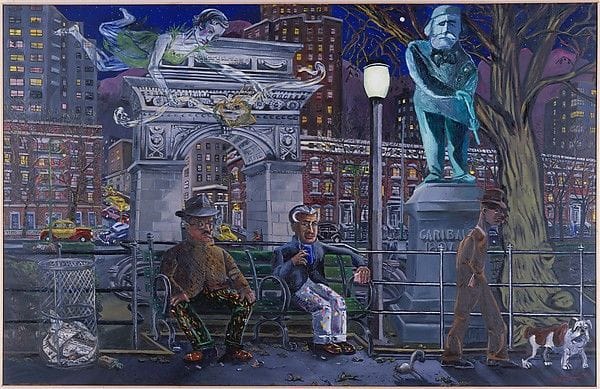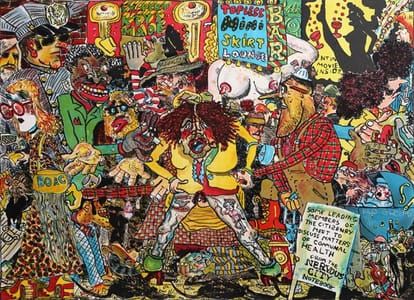

Chance Encounter at 3 A.M, 1984
Red Grooms
Born in Nashville, Tennessee, Red Grooms studied at the Art Institute of Chicago and with Hans Hofmann. He has become one of the most versatile artists of the 20th century. Working as a painter, sculptor, installation artist, draughtsman, performance artist, and filmmaker, Grooms consistently infuses his work with a whimsical sense of humor.
Often focusing on scenes from daily life, he approaches his subject through a lens of caricature and exaggeration, lending a cartoon-like quality to everyday incident.
Grooms' sculptural tableaux of the 1970s and 1980s and his life-sized environmental installations, such as the 1976 "Ruckus Manhattan," delighted viewers with its re-creation of city scenes crammed with human incident and amusing detail in a colorful and playfully naïve style.
"Chance Encounter at 3 A.M." exemplifies the artist's distinctive style in its witty observations and quirky interpretations of well-known people and places. The picture attempts to re-create the initial meeting of two great modern artists, Willem de Kooning (seated on the right) and Mark Rothko (at the left). The idea for the picture was suggested by an article on de Kooning that Grooms read in the New York Times Magazine (November 20, 1983). As recounted in the article, the two paint-splattered artists happened to sit on the same bench in Washington Square Park in New York's Greenwich Village early one morning. Although both of them had studios in the area and already knew each other's work, they had never met face to face before. While the actual meeting took place in the 1930s, Grooms mistakenly thought it had occurred in the 1950s, hence his inclusion of such period details as the large, rounded cars and newspaper headlines about the Korean War, President Eisenhower, and Nikita Khrushchev.
Grooms imagines Rothko and de Kooning eyeing each other furtively, moments before introducing themselves. A less-than-ethereal muse, elegantly clothed in a green cocktail dress and pearls, hovers overhead holding an artist's palette and brushes. As in many of his works, Grooms dramatically condensed the space, moving the statue of the Italian hero of independence Garibaldi closer to the pair than it would be in reality. By including Garibaldi and the words of George Washington on the arch, Grooms may be drawing an analogy between historical leaders who fought for political independence and the two leaders of the then-avant-garde Abstract Expressionist movement who were pursing a new artistic path.
(http://metmuseum.org/art/collection/search/483038?rss=1)
Uploaded on May 1, 2017 by Suzan Hamer
Red Grooms
artistArthur
Wait what?


